Video Cameras in Physics Class?
Twenty-five years ago, I took a physics class at Wabash College from Professor Vern Easterling. Vern was an excellent teacher — is an excellent teacher — but I way underperformed in that class. I tried to get my head around the numbers and symbols and forces I could not see. But I just didn’t get it; the physics didn’t sink in. My heart wasn’t in it.
When it was all over, I think Professor Easterling took pity on me and gave me something like a C+ in the course. I was ashamed.
I wish I could do it all over again this fall. I really wish I could break out my flip-flops and baseball cap, and get up early for physics class. And I’m not kidding.
Imagine a physics class without a three-inch thick textbook. Seriously, try to imagine a college-level physics course that includes no textbook.
It’s happening at Wabash right now. About 40 guys are taking an entry-level physics course for non-majors and they didn’t have to buy a textbook. What’s next, hot dogs without buns?
The course is the brainchild of Assistant Professor Martin Madsen, who with guidance from his department chair, Dennis Krause, has designed a physics class modeled after the hit television show Mythbusters.
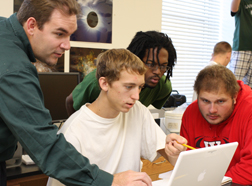 Understanding the Wabash Environment
Understanding the Wabash Environment
After spending three years on campus, Madsen started thinking about the Wabash environment and the ways Wabash guys learn. He knew that for non-majors, physics could be a challenge or, dare I say, boring. He set out to design an exciting course that would include freshmen through seniors applying their best critical thinking skills to solve problems using a Mythbusters format.
“Behind the goofy stuff they do on Mythbusters is real science, and it’s engaging, it’s fun, and it’s exciting,” Madsen says. “What if we were to do science like they do science, where we present to the students a big picture myth and just let them loose?”
As he talked to me about the class last year, he hooked me right away when he said the students wouldn’t be buying textbooks. Instead, he told me, they’d be purchasing inexpensive video cameras — the kind you see in stores for around $100 (which, by the way, is about the cost of a college physics book these days).
“We want a visual communication of the science,” the professor says. “The students have to have a good grasp of what’s happening in order to turn around and teach it to others. The video cameras become the tools for taking data in the labs and then communicating that data back out.”
It’s a fascinating concept and I’m eager to watch the series unfold this fall. Yes, the “series” will be available on the Wabash website through the
College’s YouTube channel (see Physics 105).
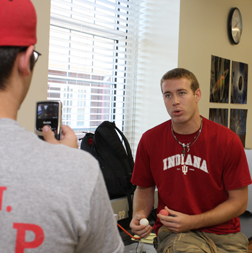 So How Does It Work?
So How Does It Work?
Professor Madsen divides the students into groups of four per team. He then throws a problem or myth at the teams, and off they go to do research into the physics, math, and common sense that will help them conduct experiments to “test” the myths and solve the problems. Their textbook is the Internet; their lab notebooks are video cameras; their homework assignments are well-edited videos that show how each team attempted to test the myth.
The myths the students must tackle involve serious science — acceleration, force, gravity, mass, math, and all things physics. The experiments also look like a lot of fun.
“The 19th century model of someone lecturing to a room full of students just doesn’t fit the 21st century, it doesn’t fit the technology, it doesn’t fit the information age, it doesn’t fit the students now or our culture,” said Madsen.
I watched a short video clip from the first “lab” session. The myth dealt with crumple zones on cars and involved crash tests. Students dressed in football helmets and shoulder pads rode on carts and barreled head-on into walls. In subsequent sessions, they attached foam padding, pop cans, plastic bottles, and trash bags with paper either to the front of the cart or the wall in which they crashed.
Translation: A large student (mass) traveled at a specified speed (velocity) striking an immovable object (force) as the cameras from various angles (including helmet-cam) captured the entire event. Accelerometers measured the affect of the impact on the passenger and computers crunched the numbers. Videos from various angles captured every second, and slow motion made the concepts easier to understand.
After that first week, Professor Madsen told me he had students coming in with big smiles saying how much they had, that they had thought about the problem all week, and how excited they were to get started on the next myth.
Madsen acknowledges the support he’s had in developing the course, and knows he wouldn’t have the opportunity at any other school.
“Being Wabash College where the attitude of the administration and the department is “let’s try it, let’s see what happens. It just makes this kind of class possible.”
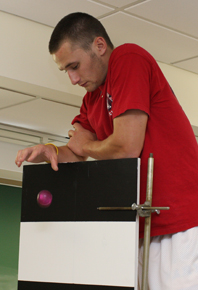 Seeing is Believing
Seeing is Believing
Thursday afternoon, I ventured over to Goodrich Hall to check in on the class as they worked through another myth. As soon as I opened the door on the north end of the building, I heard laughter and excitement — coming from the south end of the second floor!
Laughing in physics class? I remember crying…
What I saw when I entered the lab was pure, unbridled excitement for science and for discovery. Five groups of students were positioned in various parts of the lab. Some students were standing on lab tables dropping rubber balls and wads of Playdough while others captured data on mass, velocity, and force.
Like television hosts, the students introduced their experiments on camera — explaining the myth they were testing and discussing the science behind the experiments. No two teams were approaching the work in the same way or even from the same camera angles.
I stopped to talk to the Orange Team. I asked Ryan Kerney, a senior, what he thought of Professor Madsen’s creative take on physics teaching and learning.
“It’s a lot of hard work,” he said. “It’s a fun, interesting way to learn physics. And it sure beats sitting through a three-hour lecture or lab.”
Marcus Manges chimed in, saying, “These are concepts we can use throughout our lives.”
“Hard” and “physics” are two words that often go together; “fun” and “physics” not so much.
Talking with the students, observing them work the experiments, and watching the videos they produced from the first assignment taught me that Professor Madsen has a “hit show” with his Wabash version of Mythbusters.
“It Won’t Be Easy…”
In case it seems like a soft approach to physics, think again.
It’s clear to me that the students are not only taking the class seriously, they are doing a lot more work outside the lab in preparation than in the actual lab period itself.
In order to test the myths, the students have to do substantial of background research, assemble the materials they will use, run the experiments, crunch the data, and then effectively communicate what they’ve discovered. It’s the last element — effective communication of the science — that struck me as particularly valuable.
These students aren’t memorizing material simply to get through the next quiz or exam. They’re putting the concepts into action to solve problems. Producing a video throughout the process forces the students to teach the science to the viewers — to really think about what they’re learning and how the various concepts fit together. And they’re doing it in amazingly funny and creative ways.
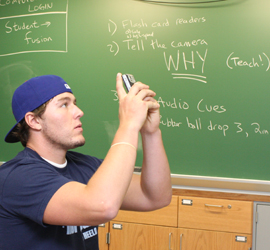 Bumps and Bruises
Bumps and Bruises
Just like the guys on the TV show Mythbusters, the Wabash students are quickly discovering that active involvement in science often comes with a few bumps and bruises. Seeing video of Marcus Manges hitting a concrete wall — over and over and in slow motion — is painful to watch. (He quickly learned to sit differently on the speeding cart, but still hit the wall hard.)
Professor Madsen was positively gleeful when he told me about the lengths the students are going to fully explore and understand each myth. Because of its size, the class is broken into two groups — five teams in the morning lab and five in the afternoon.
Thursday morning, senior Matt Hudson and his “Blue Team” comrades took the ball-dropping experiment outside — to Hollett Little Giant Stadium, where Hudson quarterbacks the football team.
“They weren’t satisfied with the data they got dropping the objects from two meters, so they went out to the stadium and dropped them from five meters,” Professor Madsen explained while laughing. “I think he’ll be all right for Saturday’s game at Chicago, but Hudson got some pretty serious welts when they dropped the objects on him!”
And Madsen is quick to acknowledge that he has a longer leash with these students because Wabash is a college for men.
“This is a class that couldn’t be taught at a research university or at almost any other college in the country,” he said. “These guys like to have fun, they like to take chances, and that’s the key to their excitement.”
Excitement and Engagement: Keys to Effective Learning
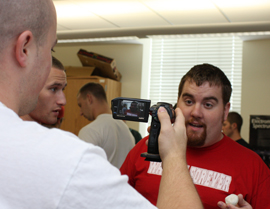
Watching Madsen work the lab with five different teams at various points in their experiments on Thursday made it clear that this class “busts the myth” about courses designed for non-majors. Unlike me 20-some years ago — a history major taking Professor Easterling’s intro physics course to fulfill a graduation requirement — Madsen’s 40-some non-majors are fully engaged in the class and in the science.
Madsen moves easily from one team to another, sharpening their focus, pushing them to think deeply, and helping them understand the physics they’re using to test the myths.
Scholars of teaching and learning would be wise to study this course. The students are learning on their own (independent study) and collaboratively with one another (peer to peer learning). They’re using Internet resources combined with a handful of lectures to work through difficult problems — these students are way beyond rote memorization (experiential learning). There is an intense engagement with the concepts and the experiments. And there is clearly a lot of teaching and learning going on informally, outside of class and far outside Goodrich Hall (extending the classroom).
With good support from his colleagues in the department and from the College, Madsen’s innovative approach to redesigning a physics course for non-majors is one to be taken seriously and watched closely.
A Team Effort
It doesn’t take long to realize that what Madsen and his students are doing in class and on the web isn’t a solo effort. In fact, there are strands of at least five different departments on campus weaving their way into Wabash’s version of Mythbusters.
“I’ve had significant help from the Media Center, IT Services, Campus Services, Athletics, Public Affairs, and the Art Department so far,” said Madsen. “I’m sure as the semester goes on, there will be more people involved, too. The development of the course has also been a team effort and I credit the environment we have here at Wabash.”
In the Photos: 1) Professor Madsen works with Purple Team members Bn Klimek, Marquise Triplett, and Skip Tokar; 2) Marcus Manges videotapes Ryan Kerney as he introduces a segment; 3) Cole Tribble of the White team drops a rubber ball from on top of the lab table; 4) Riley McGaughey shoots some video with Professor Madsen's instructions for effective communication posted on the board; 5) Zack Lanning shoots an intro by Josh Howard in the White team's video.
 Understanding the Wabash Environment
Understanding the Wabash Environment So How Does It Work?
So How Does It Work? Seeing is Believing
Seeing is Believing Bumps and Bruises
Bumps and Bruises Watching Madsen work the lab with five different teams at various points in their experiments on Thursday made it clear that this class “busts the myth” about courses designed for non-majors. Unlike me 20-some years ago — a history major taking Professor Easterling’s intro physics course to fulfill a graduation requirement — Madsen’s 40-some non-majors are fully engaged in the class and in the science.
Watching Madsen work the lab with five different teams at various points in their experiments on Thursday made it clear that this class “busts the myth” about courses designed for non-majors. Unlike me 20-some years ago — a history major taking Professor Easterling’s intro physics course to fulfill a graduation requirement — Madsen’s 40-some non-majors are fully engaged in the class and in the science.